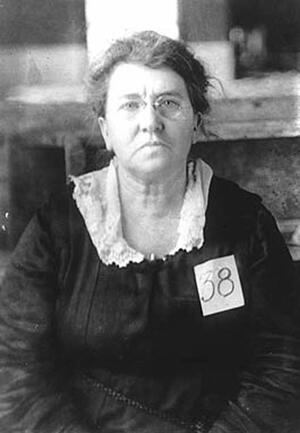Emma Goldman Released from Jail and Then Reimprisoned
Emma Goldman's deportation portrait, 1919. In post-World War I America, foreigners and their "foreign ideas" were increasingly untolerated. Following her release from prison in 1919, Goldman was immediately re-arrested on the order of J. Edgar Hoover, then director of intelligence for the U.S. Justice Department. Hoover persuaded the courts to deny Goldman's citizenship claims, thus making her liable to deportation under the 1918 Alien Act, which allowed for the expulsion of any alien found to be an anarchist. On December 21, 1919, Goldman and 248 other foreign-born radicals were deported to the Soviet Union.
Courtesy of the Emma Goldman Papers, University of California, Berkeley.
Emma Goldman was released from a two-year prison term, on September 27, 1919, only to be immediately reimprisoned. Goldman had been charged in 1917, along with her long-time comrade Alexander Berkman, for "conspiring against the draft" as a result of their work creating the No-Conscription league in May 1917 to oppose US involvement in World War I. The activists began their prison sentences in December, 1917.
After immigrating to the United States at 16 in 1885, Goldman soon became an outspoken advocate for the rights of workers and women. Incensed by the poor standard of living of the majority of workers, she began lecturing and promoting anarchism as the best method to achieve equality. Goldman's anarchistic belief in absolute freedom from governments, that served the powerful and exploited the poor and dispossessed, shaped her life-long activism.
As Goldman's prison release neared in August 1919, the director of the Justice Department's General Intelligence committee, the young J. Edgar Hoover, worked to ensure Goldman and Berkman's permanent removal from American society. Hoover pressured the courts to deny Goldman's citizenship claims, thus making her vulnerable to the 1918 Alien Act. In a letter to a governmental official, Hoover described Goldman and Berkman as "beyond doubt, two of the most dangerous anarchists in this country," concluding that they would, "if permitted to return to the community...do undue harm."
Goldman and Berkman were deported at the end of 1919 with 247 other immigrant radicals to the new Soviet Union. After less than two years in Russia, Goldman left the country disillusioned by the violence and unforgiving rule of the Bolsheviks. She spent the remainder of her life traveling throughout Europe and Canada, politically frustrated by her status as an exile. After her death, Goldman was finally readmitted to the United States and buried in Chicago.
Sources: jwa.org/womenofvalor/goldman; Emma Goldman Papers: sunsite.berkeley.edu/Goldman; Emma Goldman, Living My Life (New York, 1931).



